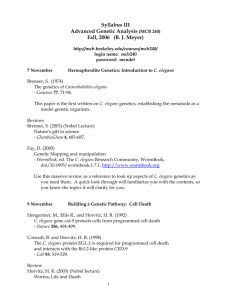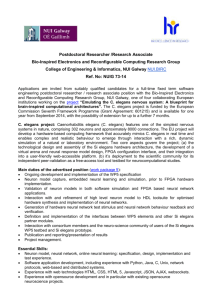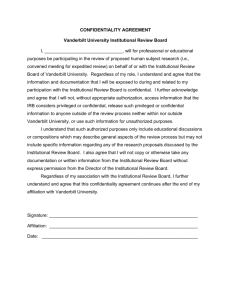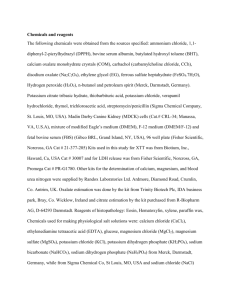doc
advertisement
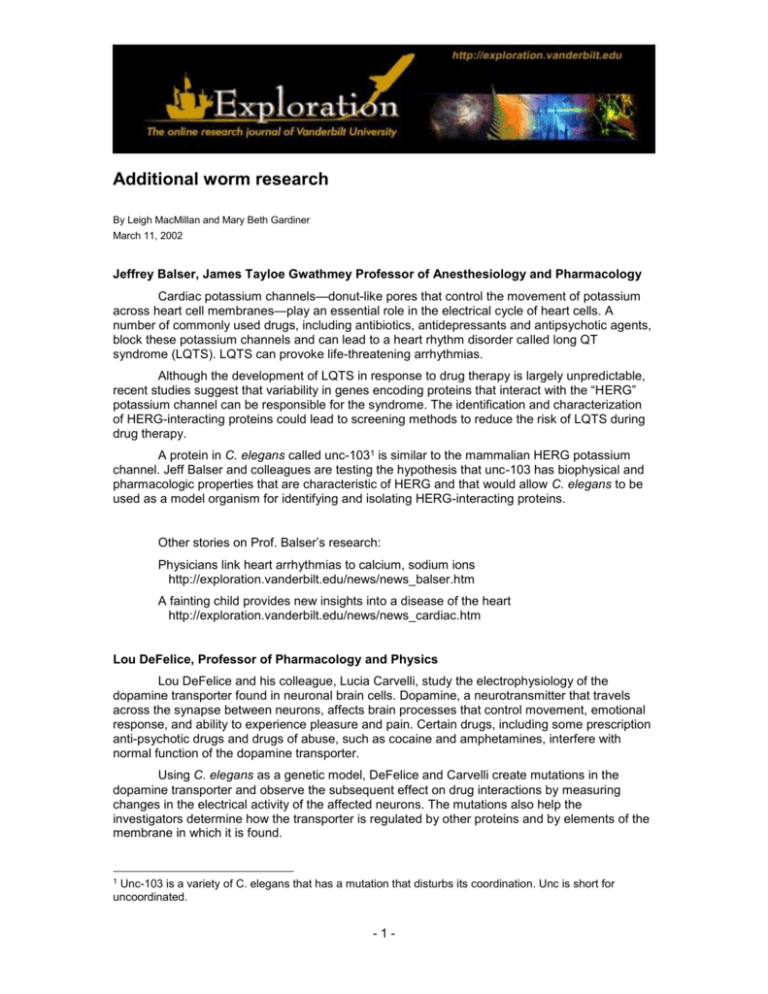
Additional worm research By Leigh MacMillan and Mary Beth Gardiner March 11, 2002 Jeffrey Balser, James Tayloe Gwathmey Professor of Anesthesiology and Pharmacology Cardiac potassium channels—donut-like pores that control the movement of potassium across heart cell membranes—play an essential role in the electrical cycle of heart cells. A number of commonly used drugs, including antibiotics, antidepressants and antipsychotic agents, block these potassium channels and can lead to a heart rhythm disorder called long QT syndrome (LQTS). LQTS can provoke life-threatening arrhythmias. Although the development of LQTS in response to drug therapy is largely unpredictable, recent studies suggest that variability in genes encoding proteins that interact with the “HERG” potassium channel can be responsible for the syndrome. The identification and characterization of HERG-interacting proteins could lead to screening methods to reduce the risk of LQTS during drug therapy. A protein in C. elegans called unc-1031 is similar to the mammalian HERG potassium channel. Jeff Balser and colleagues are testing the hypothesis that unc-103 has biophysical and pharmacologic properties that are characteristic of HERG and that would allow C. elegans to be used as a model organism for identifying and isolating HERG-interacting proteins. Other stories on Prof. Balser’s research: Physicians link heart arrhythmias to calcium, sodium ions http://exploration.vanderbilt.edu/news/news_balser.htm A fainting child provides new insights into a disease of the heart http://exploration.vanderbilt.edu/news/news_cardiac.htm Lou DeFelice, Professor of Pharmacology and Physics Lou DeFelice and his colleague, Lucia Carvelli, study the electrophysiology of the dopamine transporter found in neuronal brain cells. Dopamine, a neurotransmitter that travels across the synapse between neurons, affects brain processes that control movement, emotional response, and ability to experience pleasure and pain. Certain drugs, including some prescription anti-psychotic drugs and drugs of abuse, such as cocaine and amphetamines, interfere with normal function of the dopamine transporter. Using C. elegans as a genetic model, DeFelice and Carvelli create mutations in the dopamine transporter and observe the subsequent effect on drug interactions by measuring changes in the electrical activity of the affected neurons. The mutations also help the investigators determine how the transporter is regulated by other proteins and by elements of the membrane in which it is found. 1 Unc-103 is a variety of C. elegans that has a mutation that disturbs its coordination. Unc is short for uncoordinated. -1- Additional worm research Only six of the 300 or so neurons found in C. elegans use dopamine as a neurotransmitter. Using green fluorescent protein (GFP) to label the cells makes them easy to identify and isolate from cell culture preparations for study. Because the function of the transporter is being studied in native membrane, as opposed to the artificially constructed membranes used in most previous studies of this kind, the data should more closely reflect behavior of the transporters in the intact organism. Online information and research description: http://bret.mc.vanderbilt.edu/postdoc/cfm_files/view_facname.cfm?KeyNo=44 Alfred George, Grant W. Liddle Professor of Medicine, Associate Professor of Pharmacology Al George and colleagues are interested in a family of chloride channels—donut-like pores that control the movement of chloride ions across cell membranes. Chloride channels (ClC) are molecular participants in a variety of physiological processes including muscle cell excitation, cell volume regulation, and kidney chloride transport. The importance of these channels is underscored in human beings, where mutations in ClC genes are responsible for inherited muscle and kidney diseases. Despite their obvious significance, however, most of the identified mammalian ClC genes have no known physiological function. To sidestep the difficulty of studying chloride channels in complex organisms, George and colleagues have turned to the worm C. elegans, which has six genes that look like the mammalian chloride channels. They will use genetic manipulation and electrophysiological techniques to study this entire gene family in the worm. Their studies will shed light on the functional biology of this important class of ion channels. Online information and research description: http://bret.mc.vanderbilt.edu/cmn/cfm_files/view_facname.cfm?KeyNo=62 Kevin Strange’ Professor of Anesthesiology, Molecular Physiology & Biophysics, and Pharmacology Kevin Strange and colleagues focus on ion channels—proteins that control the passage of small charged molecules (ions) across cell membranes. Ion channels look something like donuts sitting in the cell membrane; the ions travel through the central pore of the channels. Strange is especially interested in the channels that regulate the passage of negatively charged ions like chloride. These proteins play essential roles in a variety of fundamental processes including fluid balance, membrane excitability, cell secretion and absorption, and signaling processes in and between cells. Despite their importance, however, relatively little is known about the molecular structure and regulation of these channels. Strange’s laboratory has pioneered efforts to use electrophysiological techniques like patch-clamp recording in C. elegans eggs and embryonic cells. His group has also developed C. elegans cell culture techniques to produce large quantities of various cell types for detailed molecular studies. Strange and colleagues have characterized a C. elegans chloride channel, CLH-3, that shares similarity with the mammalian chloride channel ClC-2. Strange is the principal investigator for a program project grant from the National Institute of Diabetes and Digestive and Kidney Diseases that supports research projects in four Vanderbilt laboratories. The “VUrm group” focuses on membrane transport proteins like ion channels and neurotransmitter transporters. Online information and research description: http://bret.mc.vanderbilt.edu/mstp/cfm_files/view_facname.cfm?KeyNo=163 - VU -2-



